
By Sharon Montes, MD, Living Well Health Group
*This is an article from the Summer 2021 issue of Contentment Magazine.
You can recover from past accumulation of stress, be more content, and improve resiliency for future challenges by strengthening your vagal tone. Incorporating simple practices into your daily routine will enable your vagus nerve to operate optimally for greater enjoyment of present moments.
Our nervous system exists to help us survive – quickly scanning our environment to determine if we are safe or if we need to defend ourselves. Our nervous system is a combination of fibers, chemicals and electrical signals that process up to 11 million bits of information a second.1 We are constantly receiving, integrating, and responding to information through this neural wi-fi (aka neuroception from the work of Stephen Porges, PhD). Our body’s interpretation of whether we are safe or not, is filtered by our past experience.
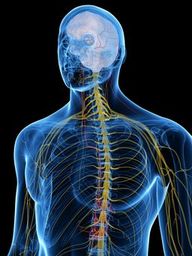
Through hacking our nervous system with physical and mental choices we can help our nervous system send the message to our cells that we are safe. The main nerve that really needs to be nourished to send those signals of safety is the vagus nerve. Our vagus nerve is an information network that spreads from head to pelvis, carrying information from our body to brain and from brain to body. The vagus nerve makes up 75% of the fibers in the parasympathetic nervous system (PNS), the part of our autonomic nervous system that allows us to have better sleep, mental calm, and tranquility. When we nourish and improve the “tone” of our vagus nerve we enjoy greater contentment and ability to connect, less pain and anxiety, and improved sleep patterns.2
As a holistic physician with a decades–long history of meditation, I noticed that I had upped my stress management game to deal with our current environment. How can I adapt to this new normal and how do I help my family, patients and community adapt? With the increased stress (demands greater than resources to meet them) I had to significantly improve my stress management practices – eliminate or reduce what didn’t work or was actually depleting resources, build on what was good, and be open to learning new strategies while in the midst of juggling everything else.
A couple of the upgrades to my nervous system included greater connection with community and learning some new ways to hack my vagus nerve. Connecting by Zoom with my former QiGong instructor and his class, offered a chance to do restorative exercise and to fast in a community setting.
Brief Map of Our Nervous System
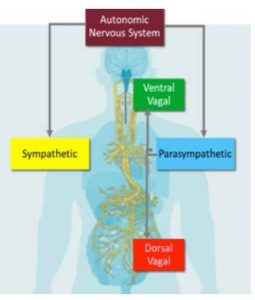
The vagus nerve is the longest cranial nerve and one of the most important nerves in the body. It helps to regulate internal organ functions from head to belly such as: sensation in our ears, speaking, swallowing, lowering our heart rate, blood pressure, respiratory rate, and digestion (stomach acid and moving food through our intestines).
A higher vagal tone indicates that the body returns to a state of relaxation more quickly after experiencing stress. As the difference increases between faster heart rates breathing in and slower rates while exhaling, so too our vagal tone improves and produces positive emotions.
Even in the midst of, or recovery from, a worldwide pandemic, we can nourish and increase our vagal nerve tone. Because these practices make us feel good, we are motivated to repeat them often.
Here Are Some Tips to Help Improve Your Vagal Tone:
Sound: Sing loudly, hum, speak, gargle, yawn, or chant to activate the vagus nerve and stimulate organ function. Also, delivery of filtered music tickles a muscle in the middle ear to gently stimulate the vagus nerve. This “passive” activation of the vagus nerve when combined with other modalities helps the nervous system relearn and send the “we are safe” message to our cells.
One form of therapeutic use of music is the Safe and Sound Protocol developed by Dr Porges. With over 20 years of research by Dr Porges and team, a playlist of five hours of music combined with other therapies has been proven to help people regulate their nervous system.3
Cold: Stimulating the vagus nerve may be as simple as drinking ice water, taking a cold shower, or splashing cold water on your face.
Meditation and Prayer: Meditation and prayer helps to create good feelings overall while at the same time improving vagal tone.
Massage: Stimulate the vagus nerve by massaging your ears and scalp or give yourself a foot massage.
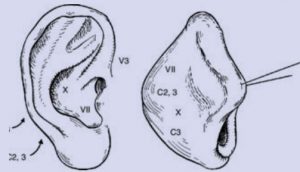
One general way of massaging the ear, most efficient to do both sides at once.
- Place your index finger behind the bottom back of your ear. Your fingertips will land in the valley behind your ear where it attaches to your skull and in front of a round bone (mastoid process).
- massage from bottom to top around the curve of your ear where the ear attaches to your head.
- repeat massage bottom to top around curve using fingertips on back of ear and thumbs in front to massage rest of back of ear
- now focus on massaging front side of ear top to bottom around the outside, moving to center
- gently massage the external ear canal
- Finish by putting gentle pressure down on the skin flap that covers the ear canal – gentle popping motion pushing that skin flap (tragus) to cover the ear canal.
Yoga and QiGong: Increase thalamic GABA levels (associated with improved mood and calmness) and vagus nerve activity with the practice of yoga or QiGong and gentle movements.
Breathing: Incorporate conscious intentional breathing, with exhaling being longer than inhaling, and a duration of about 10 to 12 seconds for each per breath. My favorite pattern is inhale 3 heart beats – hold 3 heart beats and exhale 6 heart beats (or inhale 3 second hold 2 seconds and exhale 6 seconds).
In addition, laughter and smiling, taking supplements such as probiotics and Omega-3 essential oils, combined with intermittent fasting, are all ways the vagus nerve is positively impacted. I have found that blending these vagal nerve nourishment practices gives better overall results.
After teaching laughter wellness for six years, I now prescribe resilience recipes that combine: Breathe, Movement, Positive Choice and Playful Sound.
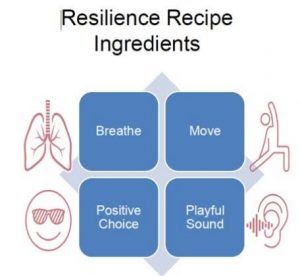
Resilience Recipes
- YES! YES! YES!
Yes: (1) Put one arm up in the air (2) Pull back your fist(s) quickly downward as you say a loud “YES!” (3) repeat with other arm (4) repeat with both arms.
2. Infinity breath: Synchronize your breath, smile, and movement as you draw a ∞ sign (it looks like a horizontal or sleeping 8) in the air. Stretch your arms out in front of you. Clasp hands together with thumbs pointing up. Look at your thumbs as you trace the infinity sign, then look beyond your hands and sway your body as you trace the infinity. Breathing up with the upstroke and down with the down stroke.
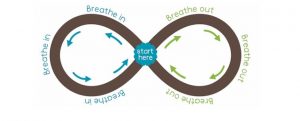
3. 3 Level Smile: Inhale as you put on a fake smile. Exhale as you relax. Then smile with cheek muscles. Exhale as you relax. Then smile with lips cheeks and eyes. Exhale as you relax.
4. 10 Finger–Tip–Touch and Sing: One finger at a time, tap each finger to its corresponding finger on the other hand. With each note, sing the words of la, la, la to the tune of Row, Row, Row Your Boat.
The vagus nerve receives and sends information from head to belly and back again. This information highway sends signals stretching from the brain, connecting to all the organs, wrapping around the digestive system and then returning to the brain. From having an impact on depression and anxiety, to improving digestion and blood pressure, to breaking down fat, stimulating the vagus nerve is a great antidote to system imbalances.4 And by incorporating some of these simple practices into our daily routine, we are helping ourselves toward greater contentment!
References
- https://www.britannica.com/science/information-theory/Physiology
- Tindle J, Tadi P. Neuroanatomy, Parasympathetic Nervous System. [Updated 2020 Nov 15]. In: StatPearls [Internet]. Treasure Island (FL): StatPearls Publishing; 2021 Jan-. Available from: https://www.ncbi.nlm.nih.gov/books/NBK553141/
- https://integratedlistening.com/ssp-safe-sound-protocol/ (www.livingwellhealthgroup.com)
- Kok BE, Coffey KA, Cohn MA, et al. How positive emotions build physical health: perceived positive social connections account for the upward spiral between positive emotions and vagal tone [published correction appears in Psychol Sci. 2016;27(6):931]. Psychol Sci. 2013; 24(7):1123-1132. doi:10.1177/0956797612470827
ABOUT THE AUTHOR

Sharon Montes, MD is a pioneer in holistic medicine. She served as both medical and education director at the University of Maryland Center for Integrative Medicine and has practiced and taught integrative medicine for over 30 years. Co-Founder of the thriving integrative practice, Living Well Health Group, based in Loveland Colorado; Dr Montes works with game changers of all ages to help them develop greater resilience. If you would like to receive a free e-book or get information about other programs, including the Heart-Centered Stress Management Program, visit www.livingwellhealthgroup.com.
Contentment Magazine
The dictionary defines “content” as being in a state of peaceful happiness. The AIS magazine is called Contentment because we want all of our guests and members to find contentment in their lives by learning about stress management and finding what works best for each them. Stress is unavoidable, and comes in many shapes and sizes that makes being in a state of peaceful happiness seem like a very lofty goal. But happiness is easy to find once you are able to find ways to manage your stress and keep a healthy perspective when going though difficult times in life. You will always have stress, but stress does not always have you!
